
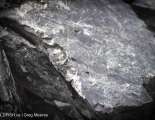

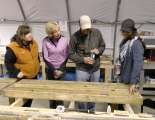
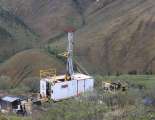
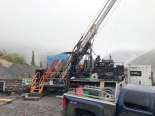


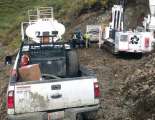


September 13, 2013, Vancouver, B.C., Prophecy Platinum Corp. (TSX-V: NKL; OTC-QX: PNIKF) “Prophecy Platinum” or the “Company” is pleased to announce the first results from the 2013 field program at its 100%-owned Wellgreen PGM-Ni-Cu project, located in the southwest of Canada’s Yukon Territory. The Company has identified a significant, newly interpreted area of mineralization towards the eastern end of the deposit that included 353 metres of continuous mineralization grading 2.62 g/t platinum equivalent (“Pt Eq.”) , comprised of 0.93 g/t 3E PGMs (Pt+Pd+Au), 0.31% Ni and 0.33% Cu. Please refer to the footnote below regarding the Company’s use of Pt Eq.
Highlights
Re-logging and analysis of previously unreleased drill core assays by the Company’s geological team has identified a broad mineralized area in the Far East Zone which is believed to extend the main Wellgreen deposit to the north. Historically, drilling in the main Wellgreen deposit was stopped upon entering the “footwall” sediments, which were assumed to be the northern boundary to mineralization. This drilling had defined the main Wellgreen deposit as a south dipping tabular body approximately 2.5 kilometres in length that is typically 100-300 metres in width with some zones of over 500 metres of continuous mineralization grading in excess of 2 g/t Pt Eq. Based on this new interpretation of drill holes in the Far East Zone, the historic footwall sediment package thought to define the northern boundary of the Wellgreen deposit does not extend to depth, but rather exhibits a wedge-like geometry. This suggests that there is potential for a large area of additional PGM-Ni-Cu mineralization in the pit model beneath and to the north of the sediment package. In addition, this newly recognized zone may connect the North Arm ultramafic body to the main Wellgreen deposit, potentially converting a large area which was modeled as unmineralized in the pit model to an area which has potential to become mineralized blocks. This could have the positive effect of reducing the life of mine strip ratio for the project.
This Far East Zone also exhibits areas of significantly higher grades than the average of the Wellgreen deposit that may be amenable to selective mining of higher grade material early in the mine life. The Far East Zone is completely open to the west, east and to the north. More exploration work is being conducted by the Company in this area to gain a better understanding of its mineralization and the broader implications for the Wellgreen deposit as a whole.
Highlight intercepts from the newly interpreted mineralized area include the following, expressed in platinum equivalent and 3E PGM (platinum + palladium + gold) (see definitions below):
1 Wellgreen is a polymetallic deposit with mineralization that includes the Platinum Group Metals (PGM’s), nickel, copper and cobalt. At current metal prices using anticipated metallurgical recoveries for separate Ni and Cu concentrates, the net economic contribution is anticipated to be largest for the 3E PGMs (Pt+Pd+Au), followed by nickel and then by copper and cobalt. A platinum equivalent value (Pt Eq) is intended to reflect total metal equivalent content in platinum for all of the metals using relative prices for each of the metals. Please see the detailed footnotes below on Table 1 for the metal prices used for this calculation.
These results indicate the potential for the Far East Zone to be laterally extensive with broad zones of significantly higher grades than the average of the Wellgreen deposit. Several of these holes contain Pt Eq. grade thickness values of 1,000 g/t-m, which are some of the best intersections to date on the project.
Greg Johnson, Prophecy Platinum’s President and Chief Executive Officer, stated, “We are excited about the implications of these drill holes and the potential to define a large block of new mineralization within the existing pit model. We are also encouraged with the presence of the wide zones of significantly higher grade, such as in hole 165 which intersected 60.7 metres of 2.01 g/t 3E PGMs with 0.24% Ni and 0.99% Cu for a total platinum equivalent grade of 4.24 g/t Pt Eq. In our current drilling, we are testing the total width of this zone with a step out to the east designed to intercept both the historic tabular Wellgreen deposit and to drill into this Far East Zone to the north. Though the assay results of this offset drill hole are pending, it has already intercepted more than 750 metres of continuous ultramafic host rock containing disseminated sulphide mineralization. In light of this new interpretation, the Company is also reviewing and assessing additional historic drilling several hundred metres east of the Far East Zone and believes that these holes may have also intercepted this new zone of mineralization.”
Mr. Johnson continued, “We are also excited to report that in our review of historical information, some of which has not previously been published, we have noted areas of strongly enriched rare platinum group metals (“PGMs”), rhodium (Rh), osmium (Os), iridium (Ir) and ruthenium (Ru). These rare PGM zones occur within and adjacent to high sulphide zones with elevated concentrations of platinum, palladium and gold. These rare PGMs are not common in magmatic PGM-Ni-Cu deposits, but these results are consistent with historic mining data for the Wellgreen concentrates; a total of 171,652 tonnes were milled by Hudson Yukon Mining in 1972 and 1973 with grades based on smelter returns of 2.23% Ni, 1.39% Cu, 1,300 ppb Pt, 920 ppb Pd, 171 ppb Au, 400 ppb Rh, 420 ppb Ru, 250 ppb Ir, 200 ppb Os and 200 ppb Re. The presence of these rare and valuable PGM metals has been shown to increase the total PGM content by 100% to 200% in some sulphide-rich samples and by 10% to 15% in adjacent and shoulder zones with high sulphide contents. Because of the potential positive economic impact of these rare PGMs, additional analyses of the full suite of PGMs in the higher sulfide intercepts and intervals are being conducted by the Company.”
Main Wellgreen Deposit and New Far East Zone Interpretation
The main Wellgreen resource area has been delineated into five zones which show broad disseminated to high sulphide mineralization contained within host ultramafic rocks. These five zones – the Far West, West, Central, East and Far East Zones – cover an area of 2.5 kilometres in length with mineralization starting at surface and extending, at the deepest known point, to at least 700 metres . These zones form a continuous, moderately to steeply south dipping tabular body of disseminated PGM, nickel and copper mineralization that is typically 100-300 metres in width with some zones of over 500 metres of continuous mineralization grading in excess of 2 g/t Pt Eq. The Far East Zone is at the eastern end of the deposit and remains open to the west, north and east towards the Quill target, which has a similar geochemical and geophysical signature to Wellgreen.
An ongoing, comprehensive review of the Wellgreen project has focused on compiling all historic information on the deposit back to the 1950s. This review has resulted in the development of a new understanding of the controls to the disseminated PGM, nickel and copper mineralization. During the review, the technical team focused on several areas of particularly wide and significantly higher grade mineralization. The Far East Zone at the eastern end of the main Wellgreen deposit is one of these areas and our new interpretation indicates the potential for a large new zone of mineralization which is distinctive from the main tabular Wellgreen deposit.
Historically, drilling in the main Wellgreen deposit was stopped upon entering the “footwall” sediments, which were assumed to be the northern boundary to mineralization. Results from the review of deeper drilling in the Far East Zone indicate the footwall sediment package does not extend completely to depth, but rather exhibits a wedge-like geometry. This suggests that this zone may extend significantly toward the west as well as toward the east and that there is potential for a broad area of additional mineralization that was not previously recognized beneath the sediment package toward the north. This new zone may connect with a second mineralized ultramafic body called the North Arm that has only limited historic drilling but that falls within the pit model.
As can be seen in the cross section and table below, the Far East Zone exhibits exceptionally wide and continuous mineralization with all four holes in the area exceeding 500 gram/tonne-metres of Pt Eq. mineralization, and WS-154 and WS-160 exceeding 900 gram/tonne-metres. WS-160 and WS-165 are approximately 150 metres apart and have different lithological and mineralization characteristics compared with the typical mineralization in the main Wellgreen tabular body, including significant enrichment of copper and platinum, which could indicate this area is part of a feeder zone or area which focused greater sulphide concentration during emplacement. Data seems to indicate that grades in this Far Eastern Zone area may be increasing with depth and that the ultramafic body is open to significant further expansion.
Drill Hole Intercept Highlights
|
Drill Hole
|
Downhole
|
Base Metals
|
Precious Metals
|
Total Metals
|
Pt Eq.-
length thickness |
3E-
length |
|||||||||
|
From
|
To
|
Width
|
Ni
|
Cu
|
Co
|
Ni Eq.
|
Pt
|
Pd
|
Au
|
3E
|
Pt Eq.
|
Ni Eq.
|
|||
|
m
|
m
|
m
|
%
|
%
|
%
|
%
|
g/t
|
g/t
|
g/t
|
g/t
|
g/t
|
%
|
g/t-m
|
g/t-m
|
|
|
WS-154
|
2.1
|
218.2
|
216.1
|
0.24
|
0.12
|
0.014
|
0.31
|
0.14
|
0.18
|
0.02
|
0.34
|
1.48
|
0.36
|
321
|
74
|
|
293.8
|
306.6
|
12.8
|
0.16
|
0.29
|
0.015
|
0.29
|
0.52
|
0.31
|
0.15
|
0.98
|
1.96
|
0.46
|
25
|
13
|
|
|
335.6
|
342.3
|
6.7
|
0.37
|
0.48
|
0.021
|
0.59
|
0.40
|
0.27
|
0.08
|
0.75
|
2.98
|
0.71
|
20
|
5
|
|
|
353.1
|
488.6
|
135.5
|
0.34
|
0.20
|
0.018
|
0.45
|
0.29
|
0.30
|
0.04
|
0.63
|
2.26
|
0.54
|
306
|
85
|
|
|
495.6
|
625.8
|
130.1
|
0.21
|
0.27
|
0.014
|
0.33
|
0.41
|
0.253
|
0.09
|
0.75
|
1.92
|
0.46
|
251
|
97
|
|
|
5 intervals
|
501.2
|
0.26
|
0.19
|
0.015
|
0.35
|
0.26
|
0.237
|
0.05
|
0.55
|
1.84
|
0.44
|
922
|
274
|
||
|
WS-165
|
361.1
|
494.5
|
133.4
|
0.26
|
0.36
|
0.017
|
0.43
|
0.46
|
0.312
|
0.112
|
0.89
|
2.43
|
0.58
|
324
|
119
|
|
|
624.5
|
685.2
|
60.7
|
0.24
|
0.99
|
0.019
|
0.64
|
1.06
|
0.534
|
0.422
|
2.02
|
4.24
|
1.00
|
257
|
122
|
|
2
intervals |
194.1
|
0.26
|
0.55
|
0.018
|
0.49
|
0.65
|
0.382
|
0.21
|
1.24
|
2.99
|
0.71
|
581
|
241
|
||
|
WS-160
|
2.7
|
93.7
|
91.0
|
0.29
|
0.17
|
0.016
|
0.38
|
0.19
|
0.256
|
0.026
|
0.47
|
1.85
|
0.45
|
169
|
43
|
|
|
362.1
|
714.8
|
352.7
|
0.31
|
0.33
|
0.020
|
0.47
|
0.49
|
0.319
|
0.121
|
0.93
|
2.62
|
0.62
|
925
|
328
|
|
2
intervals |
443.6
|
0.31
|
0.30
|
0.019
|
0.45
|
0.43
|
0.306
|
0.10
|
0.84
|
2.46
|
0.59
|
1094
|
371
|
||
|
WS-193
|
3.1
|
56.0
|
53.0
|
0.24
|
0.03
|
0.013
|
0.27
|
0.09
|
0.145
|
0.01
|
0.25
|
1.27
|
0.31
|
68
|
13
|
|
|
104.8
|
462.5
|
357.7
|
0.30
|
0.11
|
0.016
|
0.37
|
0.20
|
0.262
|
0.03
|
0.49
|
1.83
|
0.44
|
689
|
175
|
|
2
intervals |
|
|
410.7
|
0.29
|
0.10
|
0.016
|
0.36
|
0.19
|
0.247
|
0.03
|
0.46
|
1.77
|
0.43
|
726
|
188
|
*Footnotes to Drill Interval Tables and Figures: 1. Nickel equivalent (Ni Eq. %) and platinum equivalent (Pt Eq. g/t) calculations reflect total gross metal content using US$ of $7.58/lb nickel (Ni), $2.85/lb copper (Cu), $12.98/lb cobalt (Co), $1270.38/oz platinum (Pt), $465.02/oz palladium (Pd) and $1102.30/oz gold (Au) and have not been adjusted to reflect metallurgical recoveries. The above metal prices are a 20% reduction of the LME 3-year trailing average metal prices as presented in the Company’s technical report entitled “Wellgreen Project, Preliminary Economic Assessment, Yukon Canada” dated August 1, 2012 (the “2012 Wellgreen PEA”) and prepared by Andrew Carter, C.Eng., Pacifico Corpuz, P. Eng., Philip Bridson, P.Eng., and Todd McCracken, P.Geo., of Tetra Tech Wardrop Inc. The 2012 Wellgreen PEA is available under the Company’s profile on SEDAR at www.sedar.com. Ni Eq. % and Pt Eq. g/t in “Base Metals” and “Precious Metals” columns only refers to equivalents of base and precious metals respectively, not total metals. In the “Total Metals” column the Pt Eq. includes both base and precious metals, as does the Ni Eq. 3. 3E represents the sum of platinum, palladium and gold, measured in g/t. 4. Significant interval defined as a minimum 15 g/t-m Pt Eq. interval. 5. Cutoff grade of 0.2% Ni Eq. 6. Internal dilution up to six continuous metres of <0.2% Ni Eq. 7. Some rounding errors may occur. 8. True thicknesses have not been measured.
WS-160 started in mineralization associated with the main tabular Wellgreen deposit from surface, passed through the sediment zone, and then intersected 353 metres of continuous higher grade mineralization in the lower zone (see table and cross section above). WS-165 exhibited a similar pattern at approximately the same depth, though it did also intercept what is interpreted as a narrow, tabular, post-mineral dike before passing into a higher grade zone with 1% copper and 4-5 g/t Pt Eq. over 60 metres. This lower intercept in WS-165 shows a broad zone of significant enrichment of copper and platinum which may be amenable to selective mining using bulk underground methods.
As can be seen in the section and the 3D geologic model, this new area may connect the main Wellgreen deposit with the relatively untested North Arm ultramafic body. The North Arm falls within the current pit model but, due to a lack of modern drilling data, was not included in the current Mineral Resource estimate. With the current resampling effort and additional drilling the North Arm has the potential of being reclassified from unclassified material into a Resource designation which would add mineralized blocks to the Wellgreen economic model that were previously modelled as waste blocks.
The Far East Zone is significant since it indicates potential for a considerable new zone of higher grade mineralization which may connect the main Wellgreen deposit with zones to the east and north. The new zone appears to open for at least 400 metres to the west and it is fully open further east where only limited drilling has been completed. It also suggests that the North Arm may be part of a much larger ultramafic body than previously recognized giving it greater potential for expansion.
Further exploratory work is planned in this new area over the coming months to determine the extent of mineralization, its orientation, grades, and potential for bulk mineability in the first 5-10 years of mining. There are a number of broad zones of higher grade material requiring follow up which the Company will assess to determine if they can be scheduled for production, along with other higher grade zones, early in the mine plan.
2013 Field Program Update
As indicated in our previous news releases, our 2013 field program has the following key objectives:
Priority Drilling Targets
The Company identified and prioritized a series of drill hole locations for the 2013 field program based on the above parameters. The first of these drill holes was selected to significantly offset and intercept wide zones of higher grade mineralization and to demonstrate the predictability of the new 3D geologic model.
Drilling has been completed at the first of these locations, which is a step out hole collared approximately 380 metres to the south of WS-160 in the Far East Zone. This hole was designed to test the extent of the main Wellgreen tabular body to the south and to test the extent of the new Far East Zone at greater depth based on our new interpretation from holes WS-160 and WS-165. The drill hole was originally planned to extend 700 metres, but drilled to over 800 metres due to the extent of mineralization.
The next priority target is a significant offset to the south of WS-214 and WS-188 in the Central Zone. The Central Zone is one of the thickest zones of higher grade mineralization with in excess of 500 metres of continuous mineralization at more than 2 g/t Pt Eq. In the main tabular Wellgreen deposit in the Central Zone, mineralization is open to the south and untested at depth.
In addition, the Company is drilling a series of shallow drill hole targets in areas with potential for higher grade starter pits, particularly in the Far West and West Zones. Five such drill holes have been drilled this year as part of the 2013 field program, with assay results pending.
Re-Logging and Sampling of Historic Drill Holes
The re-logging and sampling program of up to 12,000 metres of historic drill holes initiated in June is approximately 66% complete. The historic drill holes were previously only selectively sampled for high-grade, massive sulphide zones amenable to an underground mining scenario. Therefore, as much as 75% of the drill core that can be considered in an open pit bulk mineable scenario was never sampled. These historic holes are now being analyzed across broad zones of disseminated sulphide mineralization for platinum, palladium, rhodium and gold (4E) in addition to nickel, copper, cobalt and trace elements. The analysis will include NI 43-101 quality control processes to allow these historic drill holes to be utilized in the next Mineral Resource update and updated 2014 PEA.
Quill and Burwash Targets
Prophecy Platinum continues to evaluate historic exploration data from the Quill and Burwash areas, both of which have a potential strike length of over 2 kilometres based on magnetic and soil geochemical anomalies. The Company has identified a series of high-priority targets in the Quill and Burwash areas, which are outside of the current limits of the current mineral resource model but demonstrate geomagnetic and surface geochemical signatures which are similar to those found at the main Wellgreen deposit. Initial results indicate the possibility that these sites may be part of the same overall system, which exceeds 18 kilometres in length.
Rare PGMs
During the compilation and review of drilling data collected on the Wellgreen project for holes WS-160 and WS-165, several additional assay certificates from Becquerel Labs of Mississauga, Ontario were identified. These certificates contained Neutron Activation (Method BQ-NAA-2) results from various drill hole pulps. The pulps were analyzed for gold and 6E PGMs (Pt, Pd, Ir, Os, Rh and Ru). Of particular importance in these results was the 10.2 metre interval from 440.74 to 450.95 metres. The interval is a zone of semi-massive sulphides in clinopyroxenite followed immediately by a zone of massive sulphides and exhibits a 17% to 212% upgrade in PGMs, with an average increase of 70%. The adjacent drill intervals above (18.9 metres) and below (12.0 metres) this section were not similarly assayed, which could mean there may be the potential to have increased PGM grades adjacent to these zones.
The Company will be focusing efforts on identifying the extent of this zone and the possibility of finding similar zones within the Wellgreen deposit. Concentrates that were historically mined and produced at Wellgreen and sold to Sumitomo in the 1970s reported significant recovery of rare PGMs along with platinum, palladium, gold, nickel and copper. Anomalous concentrations of rhodium appear to be a good proxy for zones of higher 6E PGMs. All analyses going forward will include an analysis of rhodium with a four acid digestion ICP-ES analysis (Code 7TD) through ACME Labs in Vancouver.
Looking Forward
Prophecy Platinum is very pleased with the initial results of its 2013 field program. The identification of the mineralized area in the Far East Zone below the sediment wedge was an exciting discovery and additional work will explore the orientation and potential size of this area. The Company looks forward to reporting results from our re-sampling and drilling programs in the coming weeks and months, along with our next phase of metallurgical optimization testwork.
Wellgreen is quickly becoming one of the most significant undeveloped PGM deposits in the world in terms of width and continuity of PGM mineralization. With typical mineralization widths between 100 and 300 metres and in some areas beyond 500 metres the grade thickness values demonstrate an amenability to open pit and underground bulk mining, both of which are important considerations when comparing Wellgreen to well-known new South African bulk mineable projects such as at Platreef and Waterberg. Broader mineralization widths allow for lower cost, less labour intensive mining methods. Wellgreen is located in a low political risk, mining-friendly jurisdiction with direct access to existing highways and port infrastructure.
About Prophecy Platinum
Prophecy Platinum Corp. is a PGM exploration and development company with projects in the Yukon Territory, Ontario and Manitoba, Canada. The Company’s 100% owned Wellgreen PGM-Ni-Cu project, located in the Yukon, is one of the world’s largest undeveloped PGM deposits and one of few significant PGM deposits outside of southern Africa or Russia. The Company’s Shakespeare PGM-Ni-Cu project is a fully-permitted, production-ready mine located in the Sudbury mining district of Ontario, and its Lynn Lake project is a former operating mine located in Manitoba, Canada. The Company’s experienced senior management team has a track record of successful, large-scale project discovery, development, operations and financing combined with an entrepreneurial approach to sustainability and collaboration with First Nations and communities. The Company’s shares are listed on the TSX Venture Exchange under the symbol “NKL” and on the US OTC-QX market under the symbol “PNIKF”.
Further information about the Company and its projects can be found at www.prophecyplatinum.com.
Prophecy Platinum Contacts:
|
Greg Johnson Chris Ackerman |
1-800-459-5583 |
Quality Assurance, Quality Control: The technical information in this news release has been prepared in accordance with Canadian regulatory requirements set out in National Instrument 43-101 Standards of Disclosure for Mineral Projects of the Canadian Securities Administrators (“NI 43-101″). The Wellgreen project geological technical information was prepared under the supervision of Neil Froc, P. Eng., Prophecy Platinum’s Wellgreen Project Manager, who is a “Qualified Person” as defined in NI 43-101 and the person who oversees exploration activities on the project. All other technical information was prepared under the supervision of John Sagman, P.Eng., Prophecy Platinum’s Senior Vice President and Chief Operating Officer and a “Qualified Person” as defined in NI 43-101. In addition, Mr. Sagman has reviewed and approved the geological technical information contained in this news release.
Prophecy Platinum executes a quality control program to ensure data verification using best practices in sampling and analysis. Samples are cut for assay with the remaining sample retained for reference. Blanks, Standard Reference Material (“SRM”), and duplicates were inserted into the sample stream every 25th sample. A duplicate sample is sawn in half and then sawn in half again. The quartered core is then placed into two different sample bags with different sample numbers and sealed. The SRM material comes from Natural Resources Canada and Analytical Solutions Limited. These were inserted into the sample stream immediately after the second duplicate. The SRMs used are OREAS 13P, WMS-1a, WPR-1, WGB-1, and WMG-1. Sample Blanks are obtained from garden marble from hardware stores in Whitehorse, Yukon. Assayed samples are transported in sealed and secured bags for preparation at ALS Global Prep Lab located in Whitehorse, Yukon. Pulverized (pulp) samples are shipped for analysis to ALS Global in Vancouver, B.C. Platinum, palladium and gold were determined by lead fusion fire assay with an ICP atomic emission spectrometry finish. Copper, nickel and cobalt were determined by four-acid digestion followed by an ICP atomic emission spectrometry finish. ALS Global is an ISO/IEC 17025:2005 accredited laboratory and registered under ISO 9001: 2000. ALS Global is independent from the Company.
Quality assurance and quality control are monitored using scatterplots, Thompson-Howarth plots and statistical analysis to ensure duplicates, blanks and standard data are reliable, and indicate robustness of overall results. ALS Global quality-assurance procedures are also included in this process.
Forward Looking Information: This news release includes certain information that may be deemed “forward-looking information”. Forward-looking information can generally be identified by the use of forward-looking terminology such as “may”, “will”, “expect”, “intend”, “estimate”, “anticipate”, “believe”, “continue”, “plans” or similar terminology. All information in this release, other than information of historical facts, including, without limitation, the potential of the Wellgreen project, information regarding the 2013 field program with respect to resampling, drilling, metallurgical optimization, engineering and mine planning, the timing and success of exploration activities generally, the timing of future technical reports and general future plans and objectives for the Wellgreen and Shakespeare projects are forward-looking information that involve various risks and uncertainties. Although the Company believes that the expectations expressed in such forward-looking information are based on reasonable assumptions, such expectations are not guarantees of future performance and actual results or developments may differ materially from those in the forward-looking information. Forward-looking information is based on a number of material factors and assumptions. Factors that could cause actual results to differ materially from the forward-looking information include unsuccessful exploration results, changes in project parameters as plans continue to be refined, results of future resource estimates, future metal prices, availability of capital and financing on acceptable terms, general economic, market or business conditions, uninsured risks, regulatory changes, defects in title, availability of personnel, materials and equipment on a timely basis, accidents or equipment breakdowns, delays in receiving government approvals, the Company’s ability to maintain the support of stakeholders necessary to develop the Wellgreen project, unanticipated environmental impacts on operations and costs to remedy same, and other exploration or other risks detailed herein and from time to time in the filings made by the Company with securities regulatory authorities in Canada. Readers are cautioned that mineral resources that are not mineral reserves do not have demonstrated economic viability. Mineral exploration and development of mines is an inherently risky business. Accordingly, actual events may differ materially from those projected in the forward-looking information. For more information on the Company and the risks and challenges of our business, investors should review our annual filings which are available at www.sedar.com. The Company does not undertake to update any forward looking information, except in accordance with applicable securities laws.
“Neither the TSX Venture Exchange nor its Regulation Services Provider (as that term is defined in the policies of the TSX Venture Exchange) accepts responsibility for the adequacy or accuracy of this release.”
420-1090 West Georgia Street
Vancouver, BC Canada V6E 3V7
© Copyright 2014 Wellgreen Platinum Ltd. All Rights Reserved